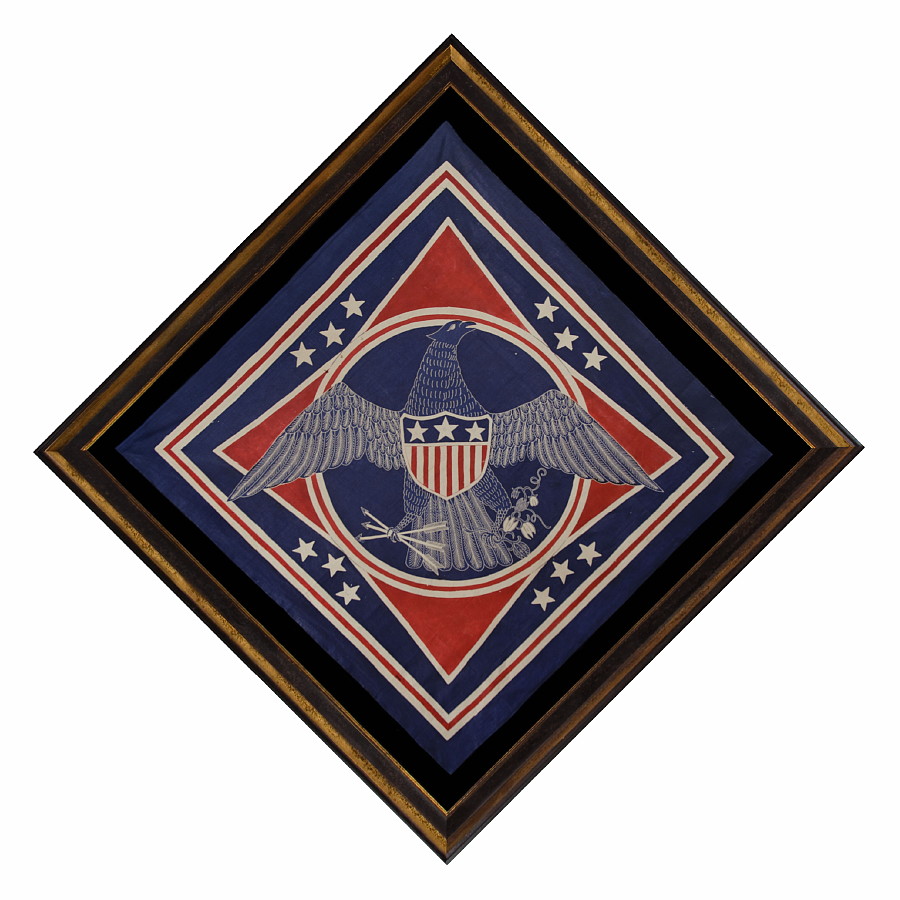
| |
PATRIOTIC BANNER WITH AMERICAN EAGLE, WITH RICH COLORS AND STRONG GRAPHICS, POSSIBLY COMMISSIONED BY THE LOTOS CLUB OF NEW YORK TO CELEBRATE THE END OF WWI (U.S. INVOLVEMENT 1917-18): |
|
| Available: |
Sold |
| Frame Size (H x L): |
Apporox. 52" x 53" |
| Flag Size (H x L): |
41.25" x 42" |
|
| Description....: |
|
PATRIOTIC BANNER WITH AMERICAN EAGLE, WITH RICH COLORS AND STRONG GRAPHICS, POSSIBLY COMMISSIONED BY THE LOTOS CLUB OF NEW YORK TO CELEBRATE THE END OF WWI (U.S. INVOLVEMENT 1917-18):
This large and beautiful, patriotic eagle textile, dates to America's involvement in WWI (1917-18). Made in the Arts & Crafts era, the craftsmanship employed in its manufacture is indicative of the level of sophistication and care taken in this robust period of American art. At the same time, however, the banner's construction represents a wide deviation from the norm with regard to printed textiles. To apply the blue and red ink in an appropriate fashion, the cloth was painstakingly stamped and brushed by hand with a resist solution that kept the color from adhering in the areas that remained white. With the exception of some clamp-dyed wool flags, the resist dye process simply isn't seen in American textiles that were produced for display at political and otherwise patriotic events.
The large scale of the banner is both bold and unusual, as-is the diagonal format. Presently it is one-of-a-kind among known examples. Beyond being unique in my experience, I have neither owned nor seen a related textile that dates to this era. The cotton is lightweight, but probably twice as thick and densely woven as an average political campaign kerchief. At 41 x 42 inches, the size is approximately equivalent to the footprint of 4 average kerchiefs laid in a square, but perhaps the most peculiar thing about it is its finish, which appears to be oilcloth and has a sheen not unlike early cotton chintz
The deep indigo dye and the scarlet red are striking. The style of the eagle is more angular than usual, and while its lines are basically familiar, the lotus flowers grasped in its left talon most certainly are not. The reason for their presence remains unknown. One potential theory is that the banner may have been commissioned by the Lotos Club of New York at the end of WWI. Dedicated to literature and the sciences, The Lotos Club is a former men's club (today admitting women) that uses a variation on the spelling of the flower's name. An American flag with an illustration of a lotus flower over the stripes, printed on paper, was formerly part of the collection of Boleslaw and Marie D'Otrange Mastai and appears on page 193 of their landmark book of flags entitled "The Stars & The Stripes" (Alfred A. Knopf, Inc., New York, 1973). According to Mastai, the flag was used at the Lotos Club in 1904. While it is nearly impossible to determine if the two are definitely related, because the representations of the flowers on the two objects are not the same, the club seems a viable enough source. There was a great deal of fanfare in New York following the war, the textile in question required unusual skill in manufacture and was probably expensive to produce, and why else might someone use vines of lotus flowers in place of the traditional olive branch?
A patriotic American shield on the eagle's breast bears three stars. This number is seen on many similar shields and may have no particular meaning, but note how the number is mirrored, not only in the 4 groups of stars that flank the medallion image, but also in the count of arrows in the eagle's right talon.
Whatever the case may be regarding the imagery set forth on this rare and interesting textile, its bold variation of a classic American symbol, with rich colors and graphics, results in a fantastic banner of the WWI era.
Mounting: The banner has been hand-stitched to 100% cotton twill, black in color, which has been washed to remove excess dye. An acid-free agent was added to the wash to further set the dye and the fabric was heat-treated for the same purpose. The mount was then placed in a black-painted, hand-gilded and distressed Italian molding. The glazing is U.V. protective acrylic.
Condition: Excellent. |
|
|
|
| Collector Level: |
Advanced Collectors and the Person with Everything |
|
| Flag Type: |
|
|
| Star Count: |
|
|
| Earliest Date of Origin: |
1917 |
|
| Latest Date of Origin: |
1918 |
|
| State/Affiliation: |
|
|
| War Association: |
WW 1 |
|
| Price: |
SOLD |
|
| |
Views: 2625 |
|
|
|

